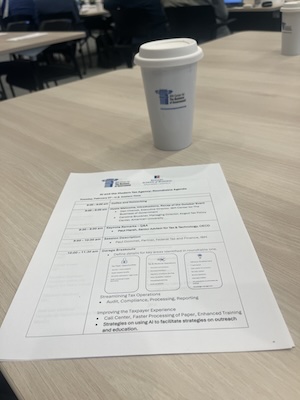
Streamlining Tax Operations with AI

Blog Author: Collin Coil, Research Assistant, Kogod Tax Policy Center
The roundtable included some 50 tax agency leaders, academics, think tanks, and thought leaders from 12 countries.
We mentioned in our previous blog that in addition to our discussion with keynote speaker, Paul Marsh of the Organization for Economic Cooperation and Development Forum on Tax Administrators (FTA), participants also identified key indicators of success in two discussions, one on “Improving the Taxpayer Experience" and another on “Streamlining Tax Operations.”
This blog will focus on our design thinking session for “Streamlining Tax Operations” where our key questions included:
- How might AI optimize audit activities?
- How might an organization leverage AI and ML to increase tax compliance rates?
- How might an organization improve processing and reporting to better inform tax administration success overall?
- What other specific pain points might be alleviated by the emerging technologies of AI, ML, and Automation?
Participants defined four goals associated with the use of AI and streamlining tax operations:
- Improve customer/taxpayer experience and satisfaction:
- Offer personalized support and assistance through various channels, such as phone, email, and live chat.
- Implement user-friendly features like auto-population of tax return information, electronic signature options, and instant confirmation of receipt.
- Process refunds faster:
- Implement a streamlined refund process that reduces processing time and issues refunds promptly.
- Provide taxpayers with real-time updates on the status of their refunds through online portals or mobile apps.
- Provide increased personalization:
- Use data analytics and machine learning algorithms to identify patterns and trends in taxpayer behavior and tailor communications and services accordingly.
- Offer personalized tax planning resources and recommendations based on taxpayers' individual circumstances and goals.
- Increase audit speed and efficiency:
- Implement data-driven audit selection and risk assessment processes to identify high-risk returns and allocate resources more effectively.
- Use machine learning and natural language processing to automate the review of tax returns and identify potential issues before they are identified by human auditors.
- Provide taxpayers with real-time updates on the status of their audits and offer digital tools for submitting documentation and responding to audit inquiries.
Some tactics discussed for reaching the four goals includes:
- Training tax agency officials on the appropriate use of AI to best understand the benefits and constraints:
- Develop comprehensive training programs that cover the basics of AI, its applications in tax administration, and the ethical considerations involved.
- Provide hands-on training sessions where officials can work with AI tools and platforms to gain practical experience.
- Offer regular updates and refresher courses to ensure that officials stay up-to-date with the latest advancements in AI technology.
- Encourage collaboration between officials to share knowledge and best practices in using AI.
- Using demonstrations to enable users to visualize the advantages of using AI:
- Create interactive demos that showcase the capabilities of AI in tax administration.
- Use real-life scenarios to illustrate the benefits of AI, such as reduced processing times, improved accuracy, and enhanced customer service.
- Provide step-by-step walkthroughs of AI-powered processes to help users understand how they work and how they can be integrated into their workflows.
- Developing models for future auditing, resulting in a more efficient use of resources:
- Develop and train machine learning models that can identify high-risk returns and detect fraudulent activities.
- Use data analytics to identify patterns and trends in taxpayer behavior and tailor audit strategies accordingly.
- Implement automated audit processes that can analyze large volumes of data quickly and accurately, freeing up human auditors to focus on complex cases.
- Monitor and evaluate the performance of AI-powered audit processes to continually improve their effectiveness and efficiency.
- Leveraging AI to provide personalized taxpayer and workforce experiences:
- Use natural language processing and machine learning algorithms to analyze taxpayer interactions and provide personalized responses and recommendations.
- Implement chatbots and virtual assistants that can offer tailored support and assistance to taxpayers based on their individual circumstances and needs.
- Provide personalized learning and development opportunities for tax agency staff, tailoring training programs to their specific roles and needs.
- Use AI-powered tools to identify employee skills and knowledge gaps, and provide targeted training and development resources to address them.
- Using AI to provide faster refunds and streamlined communication between the government and taxpayer:
- Use machine learning algorithms to identify patterns in taxpayer behavior and predict refund timelines, enabling taxpayers to track their refunds in real-time.
- Provide taxpayers with personalized communication and updates on their refund status, using channels such as email, SMS, or mobile apps.
- Use natural language processing to analyze taxpayer inquiries and provide automated responses, reducing the need for human intervention and improving communication efficiency.
Participants discussed the many internal and external challenges, but focused heavily on what processes are currently making the agency successful. It was clear that the IRS and global tax agency leaders sought to understand the dependencies that may impact the success of AI in tax agencies. These include sufficient funding, as well as public trust in the tax system. Global collaboration to advance AI in tax agencies is a crucial dependency. Finally, attracting AI talent to federal spaces is essential to ensuring that tax agencies will implement AI responsibly.
In our next blog post, we will discuss the design thinking session, “Improving the Taxpayer Experience."



